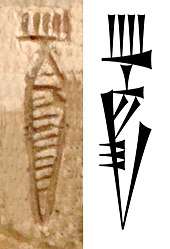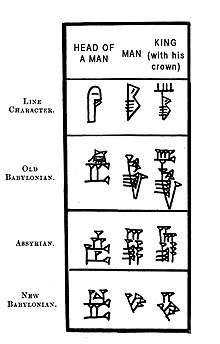Lugal
Lugal (Sumerian: 𒈗) is the Sumerian term for "king, ruler". Literally, the term means "big man."[1] In Sumerian, lu "𒇽" is "man" and gal "𒃲" is "great," or "big."[2]
It was one of several Sumerian titles that a ruler of a city-state could bear (alongside en and ensi, the exact difference being a subject of debate). The sign eventually became the predominant logograph for "King" in general. In the Sumerian language, lugal is used to mean an owner (e.g. of a boat or a field) or a head (of a unit such as a family).[3]
As a cuneiform logograph (Sumerogram) LUGAL (Unicode: 𒈗, rendered in Neo Assyrian).
Cuneiform

The cuneiform sign LUGAL 𒈗 (Borger nr. 151, Unicode U+12217) serves as a determinative in cuneiform texts (Sumerian, Akkadian and Hittite), indicating that the following word is the name of a king. In Akkadian orthography, it may also be a syllabogram šàr, acrophonically based on the Akkadian for "king", šarrum.
Lugal, ensi and en

There are different theories regarding the meaning of the title lugal in 3rd-millennium Sumer. Some scholars believe that a ruler of an individual city-state was usually called ensi, and a ruler who headed a confederacy or larger dominion composed of several cities, perhaps even the whole of Sumer, was a lugal. The functions of such a lugal would include certain ceremonial and cultic activities, arbitration in border disputes, military defence against external enemies, and once the lugal has died, the eldest son must take over.[3][4] The ensis of Lagash would sometimes refer to the city's patron deity, Ningirsu, as their lugal ("master"). All of the above is connected to the possibly priestly or sacral character of the titles ensi[5] and especially en (the latter term continuing to designate priests in subsequent times).
Other scholars consider ensi, en and lugal to have been merely three local designations for the sovereign, accepted respectively in the city-states of Lagash, Uruk and Ur (as well as most of the rest of Sumer),[5][6][7] although the various terms may have expressed different aspects of the Mesopotamian concept of kingship.[5] A lugal at that time is assumed to have been "normally a young man of outstanding qualities from a rich landowning family."[8] Thorkild Jacobsen theorized that he was originally an (elected) war leader, as opposed to the (likewise elected) en, who dealt with internal issues.[9]
Among the earliest rulers whose inscriptions describe them as lugals are Enmebaragesi and Mesilim at Kish, and Meskalamdug, Mesannepada and several of their successors at Ur.[10] At least from the Third Dynasty of Ur onwards, only lugal was used to designate a contemporary sovereign in Sumerian.
Lugal in the Amarna letters
The term Lugal is used extensively in the Amarna letters, for addressing kings or pharaohs, and elsewhere in speaking about various kings. One common address, in the introduction of many letters, from the vassals writing to the pharaoh was to use: Šàr-ri, (for šarrum); they used Lugal + ri = Šàr-ri, (i.e. Pharaoh, or King of, Ancient Egypt). (Ri is one of the more commonly used hieroglyphs, in many cases for the use of the "r").
Notes
| Look up 𒈗 in Wiktionary, the free dictionary. |
- Harriet Crawford (29 August 2013). The Sumerian World. Routledge. p. 283. ISBN 978-1-136-21912-2.
- Watson E. Mills; Roger Aubrey Bullard (1990). Mercer Dictionary of the Bible. Mercer University Press. p. 975. ISBN 978-0-86554-373-7.
- Westenholz, Aage (2002), Hansen, Morgens Herman (ed.), ""The Sumerian city-state" A comparative study of six city-state cultures: an investigation conducted by the Copenhagen Polis Center", Historisk-filosofiske Skrifter, Copenhagen: C.A. Reitzels Forlag, 23-42. (27): 34–35
- Plamen Rusev, Mesalim, Lugal Na Kish: Politicheska Istoriia Na Ranen Shumer (XXVIII-XXVI V. Pr. N. E.), Faber, 2001 (in Bulgarian) Mesalim, Lugal of Kish. Political History of Early Sumer (XXVIII–XXVI century BC.)
- Glassner, Jean-Jacques, 2000: Les petits etats Mésopotamiens à la fin du 4e et au cours du 3e millénaire. In: Hansen, Mogens Herman (ed.) A Comparative Study of Thirty City-State Cultures. The Royal Danish Academy of Sciences and Letters, Copenhagen., P.48
- Michalowski, Piotr (2008), Brisch, N. (ed.), "The Mortal Kings of Ur: A Short Century of Divine Rule in Ancient Mesopotamia" (PDF), Religion and Power: Divine Kingship in the Ancient World and Beyond, Chicago: The Oriental Institute: 33
- Cooper, Jerrold S., Sumerian and Semitic Writing in Most Ancient Syro-Mesopotamia. P.63-65. In: "Languages and Cultures in Contact. At the Crossroads of Civilizations in the Syro-Mesopotamian Realm." Proceedings of the 42nd RAI - Orientalia Lovaniensia Analecta 96, K. Van Lerberghe and G. Voet (eds.), Leuven
- H.W.F. Saggs, Babylonians, University of Oklahoma Press (1995), page 54.
- Jacobsen, Thorkild,, 1970: "Early political development in Mesopotamia," ZA 52: 91-140; repr. in TIT 132-156, 366-396.
- Glassner, Jean-Jacques, 2000: Les petits etats Mésopotamiens à la fin du 4e et au cours du 3e millénaire. In: Hansen, Mogens Herman (ed.) A Comparative Study of Thirty City-State Cultures. The Royal Danish Academy of Sciences and Letters, Copenhagen., P.47